Abstract
A survey of 930 ovine sera and kidneys from 33 sheep was conducted to assess the rate of leptospiral infection in sheep slaughtered in Alberta. Sera were tested for the presence of agglutinins to indigenous serovars of Leptospira interrogans. Kidneys with gross lesions were examined for the presence of leptospires by means of an indirect fluorescent antibody test (FAT) and by culture. Antibodies to serovars pomona and hardjo were present at rates of 1.0% and 0.4%, respectively, in sheep from Saskatchewan, Alberta and British Columbia. Sera from 120 feedlot lambs shipped from Oregon reacted to serovars pomona, hardjo and grippotyphosa at rates of 1.7%, 61.7% and 59.1%, respectively. Fluorescent antibody test detected serovars (presumptively) hardjo in 52% of Oregon feedlot lambs and grippotyphosa in 32% of the same group, a finding supported by the isolation of both these serovars from a pool of two fluorescent antibody test-positive kidneys. The grippotyphosa strain was highly virulent for hamsters, producing intense icterus and death. Leptospires, presumptively serovar grippotyphosa were demonstrated by fluorescent antibody test in one Alberta lamb kidney. The possibility of spreading leptospirosis by movement of breeding stock through public facilities and by assembling lambs in feedlots is discussed.
Keywords: Leptospirosis, sheep, Saskatchewan, Alberta, British Columbia, Oregon, hardjo, grippotyphosa, pomona
Full text
PDF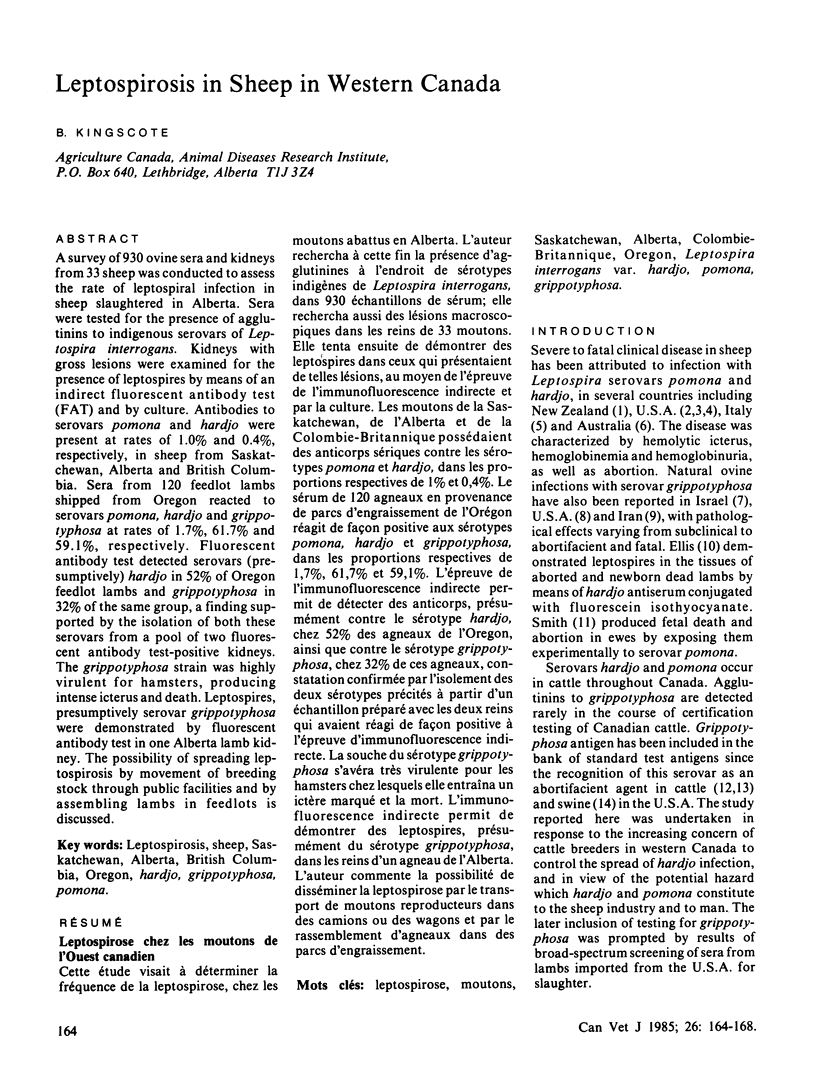
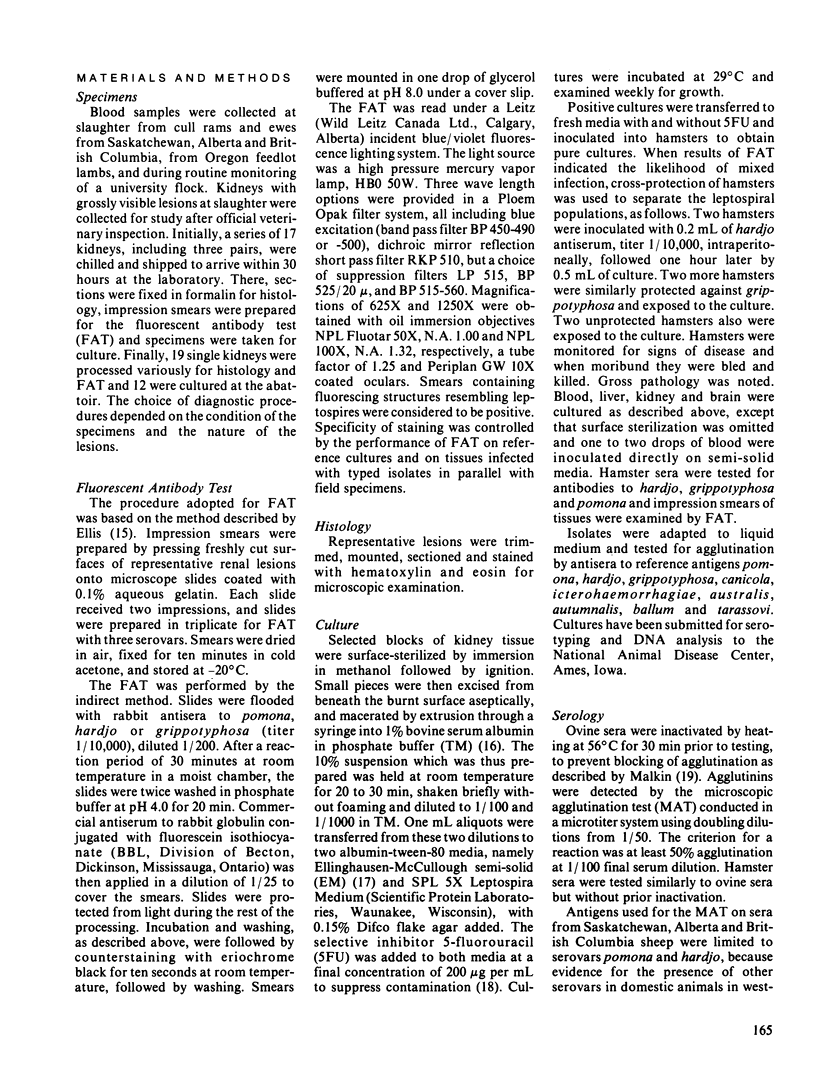
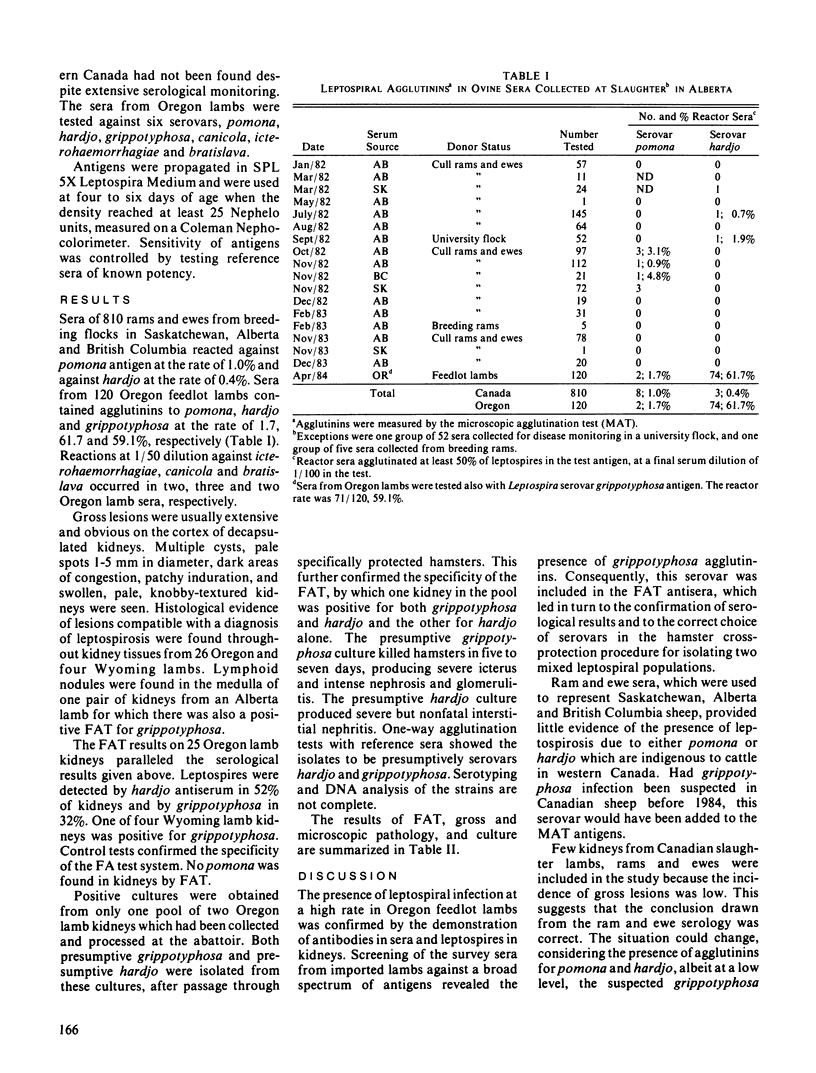
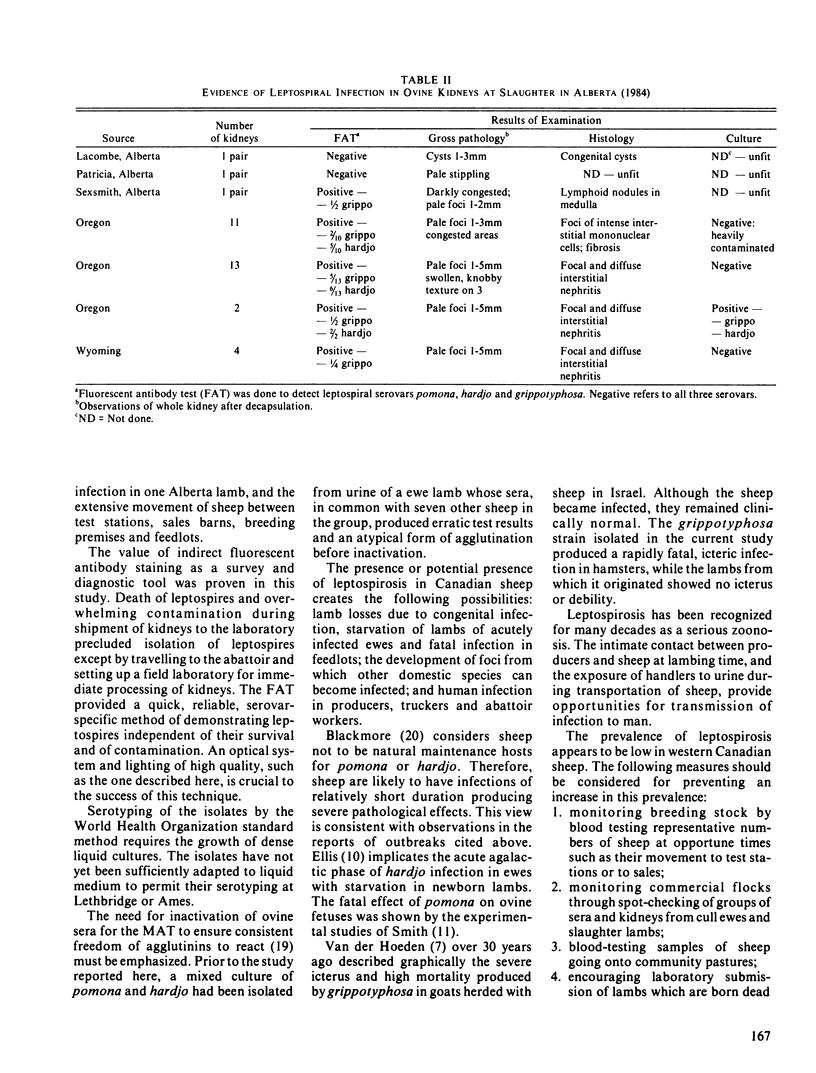
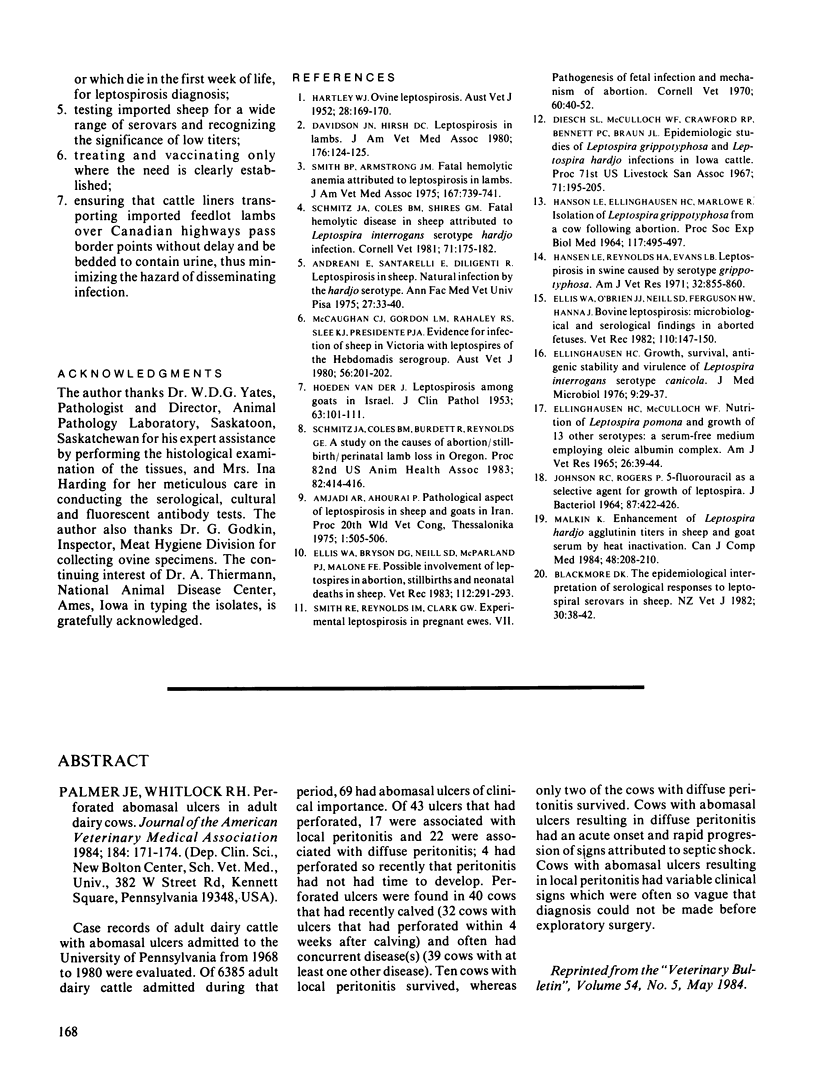
Selected References
These references are in PubMed. This may not be the complete list of references from this article.
- Blackmore D. K., Bahaman A. R., Marshall R. B. The epidemiological interpretation of serological responses to leptospiral serovars in sheep. N Z Vet J. 1982 Apr;30(4):38–42. doi: 10.1080/00480169.1982.34873. [DOI] [PubMed] [Google Scholar]
- Davidson J. N., Hirsh D. C. Leptospirosis in lambs. J Am Vet Med Assoc. 1980 Jan 15;176(2):124–125. [PubMed] [Google Scholar]
- Diesch S. L., McCulloch W. F., Crawford R. P., Bennett P. C., Braun J. L. Epidemiologic studies of Leptospira grippotyphosa and Leptospira hardjo infections in Iowa cattle. Proc Annu Meet U S Anim Health Assoc. 1967;71:195–205. [PubMed] [Google Scholar]
- ELLINGHAUSEN H. C., Jr, MCCULLOUGH W. G. NUTRITION OF LEPTOSPIRA POMONA AND GROWTH OF 13 OTHER SEROTYPES: A SERUM-FREE MEDIUM EMPLOYING OLEIC ALBUMIN COMPLEX. Am J Vet Res. 1965 Jan;26:39–44. [PubMed] [Google Scholar]
- Ellinghausen H. C., Painter G. M. Growth, survival, antigenic stability, and virulence of Leptospira interrogans serotype canicola. J Med Microbiol. 1976 Feb;9(1):29–37. doi: 10.1099/00222615-9-1-29. [DOI] [PubMed] [Google Scholar]
- Ellis W. A., Bryson D. G., Neill S. D., McParland P. J., Malone F. E. Possible involvement of leptospires in abortion, stillbirths and neonatal deaths in sheep. Vet Rec. 1983 Mar 26;112(13):291–293. doi: 10.1136/vr.112.13.291. [DOI] [PubMed] [Google Scholar]
- Ellis W. A., O'Brien J. J., Neill S. D., Ferguson H. W., Hanna J. Bovine leptospirosis: microbiological and serological findings in aborted fetuses. Vet Rec. 1982 Feb 13;110(7):147–150. doi: 10.1136/vr.110.7.147. [DOI] [PubMed] [Google Scholar]
- HANSON L. E., ELLINGHAUSEN H. C., MARLOWE R. ISOLATION OF LEPTOSPIRA GRIPPOTYPHOSA FROM A COW FOLLOWING AN ABORTION. Proc Soc Exp Biol Med. 1964 Nov;117:495–497. doi: 10.3181/00379727-117-29618. [DOI] [PubMed] [Google Scholar]
- Hanson L. E., Reynolds H. A., Evans L. B. Leptospirosis in swine caused by serotype grippotyphosa. Am J Vet Res. 1971 Jun;32(6):855–860. [PubMed] [Google Scholar]
- JOHNSON R. C., ROGERS P. 5-FLUOROURACIL AS A SELECTIVE AGENT FOR GROWTH OF LEPTOSPIRAE. J Bacteriol. 1964 Feb;87:422–426. doi: 10.1128/jb.87.2.422-426.1964. [DOI] [PMC free article] [PubMed] [Google Scholar]
- Malkin K. Enhancement of Leptospira hardjo agglutination titers in sheep and goat serum by heat inactivation. Can J Comp Med. 1984 Apr;48(2):208–210. [PMC free article] [PubMed] [Google Scholar]
- Schmitz J. A., Coles B. M., Shires G. M. Fatal hemolytic disease in sheep attributed to Leptospira interrogans serotype hardjo infection. Cornell Vet. 1981 Apr;71(2):175–182. [PubMed] [Google Scholar]
- Smith B. P., Armstrong J. M. Fatal hemolytic anemia attributed to leptospirosis in lambs. J Am Vet Med Assoc. 1975 Oct 15;167(8):739–741. [PubMed] [Google Scholar]
- Smith R. E., Reynolds I. M., Clark G. W. Experimental leptospirosis in pregnant ewes. VII. Pathogenesis of fetal infection and mechanism of abortion. Cornell Vet. 1970 Jan;60(1):40–52. [PubMed] [Google Scholar]
- VAN DER HOEDEN J. Leptospirosis among goats in Israel. J Comp Pathol. 1953 Apr;63(2):101–111. doi: 10.1016/s0368-1742(53)80012-3. [DOI] [PubMed] [Google Scholar]


